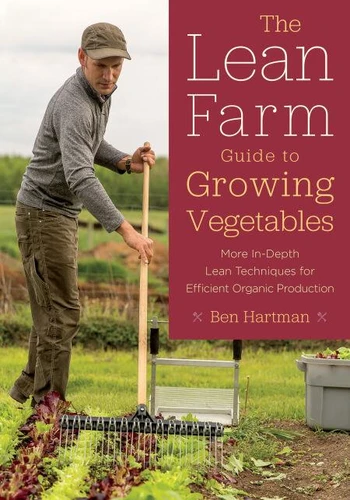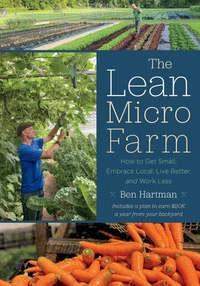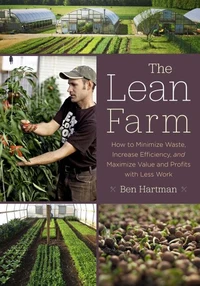The Lean Farm Guide to Growing Vegetables. More In - Depth Lean Techniques for Efficient Organic Production
Par :Formats :
Disponible dans votre compte client Decitre ou Furet du Nord dès validation de votre commande. Le format ePub protégé est :
- Compatible avec une lecture sur My Vivlio (smartphone, tablette, ordinateur)
- Compatible avec une lecture sur liseuses Vivlio
- Pour les liseuses autres que Vivlio, vous devez utiliser le logiciel Adobe Digital Edition. Non compatible avec la lecture sur les liseuses Kindle, Remarkable et Sony
- Non compatible avec un achat hors France métropolitaine
 , qui est-ce ?
, qui est-ce ?Notre partenaire de plateforme de lecture numérique où vous retrouverez l'ensemble de vos ebooks gratuitement
Pour en savoir plus sur nos ebooks, consultez notre aide en ligne ici
- Nombre de pages272
- FormatePub
- ISBN978-1-60358-700-6
- EAN9781603587006
- Date de parution10/11/2017
- Protection num.Adobe DRM
- Taille218 Mo
- Infos supplémentairesepub
- ÉditeurChelsea Green
Résumé
At Clay Bottom Farm, author Ben Hartman and staff practice kaizen, or continuous improvement, cutting out more waste-of time, labor, space, money, and more-every year and aligning their organic production more tightly with customer demand. Applied alongside other lean principles originally developed by the Japanese auto industry, the end result has been increased profits and less work. In this field-guide companion to his award-winning first book, The Lean Farm, Hartman shows market vegetable growers in even more detail how Clay Bottom Farm implements lean thinking in every area of their work, including using kanbans, or replacement signals, to maximize land use; germination chambers to reduce defect waste; and right-sized machinery to save money and labor and increase efficiency.
From finding land and assessing infrastructure needs to selling perfect produce at the farmers market, The Lean Farm Guide to Growing Vegetables digs deeper into specific, tested methods for waste-free farming that not only help farmers become more successful but make the work more enjoyable. These methods include: Using Japanese paper pot transplanters Building your own germinating chambers Leaning up your greenhouse Making and applying simple composts Using lean techniques for pest and weed control Creating Heijunka, or load-leveling calendars for efficient planning Farming is not static, and improvement requires constant change.
The Lean Farm Guide to Growing Vegetables offers strategies for farmers to stay flexible and profitable even in the face of changing weather and markets. Much more than a simple exercise in cost-cutting, lean farming is about growing better, not cheaper, food-the food your customers want."With this book, however, I believe Ben has taken our craft to new levels with fresh ideas and different strategies."-Jean-Martin Fortier, author of The Market Gardener
From finding land and assessing infrastructure needs to selling perfect produce at the farmers market, The Lean Farm Guide to Growing Vegetables digs deeper into specific, tested methods for waste-free farming that not only help farmers become more successful but make the work more enjoyable. These methods include: Using Japanese paper pot transplanters Building your own germinating chambers Leaning up your greenhouse Making and applying simple composts Using lean techniques for pest and weed control Creating Heijunka, or load-leveling calendars for efficient planning Farming is not static, and improvement requires constant change.
The Lean Farm Guide to Growing Vegetables offers strategies for farmers to stay flexible and profitable even in the face of changing weather and markets. Much more than a simple exercise in cost-cutting, lean farming is about growing better, not cheaper, food-the food your customers want."With this book, however, I believe Ben has taken our craft to new levels with fresh ideas and different strategies."-Jean-Martin Fortier, author of The Market Gardener
At Clay Bottom Farm, author Ben Hartman and staff practice kaizen, or continuous improvement, cutting out more waste-of time, labor, space, money, and more-every year and aligning their organic production more tightly with customer demand. Applied alongside other lean principles originally developed by the Japanese auto industry, the end result has been increased profits and less work. In this field-guide companion to his award-winning first book, The Lean Farm, Hartman shows market vegetable growers in even more detail how Clay Bottom Farm implements lean thinking in every area of their work, including using kanbans, or replacement signals, to maximize land use; germination chambers to reduce defect waste; and right-sized machinery to save money and labor and increase efficiency.
From finding land and assessing infrastructure needs to selling perfect produce at the farmers market, The Lean Farm Guide to Growing Vegetables digs deeper into specific, tested methods for waste-free farming that not only help farmers become more successful but make the work more enjoyable. These methods include: Using Japanese paper pot transplanters Building your own germinating chambers Leaning up your greenhouse Making and applying simple composts Using lean techniques for pest and weed control Creating Heijunka, or load-leveling calendars for efficient planning Farming is not static, and improvement requires constant change.
The Lean Farm Guide to Growing Vegetables offers strategies for farmers to stay flexible and profitable even in the face of changing weather and markets. Much more than a simple exercise in cost-cutting, lean farming is about growing better, not cheaper, food-the food your customers want."With this book, however, I believe Ben has taken our craft to new levels with fresh ideas and different strategies."-Jean-Martin Fortier, author of The Market Gardener
From finding land and assessing infrastructure needs to selling perfect produce at the farmers market, The Lean Farm Guide to Growing Vegetables digs deeper into specific, tested methods for waste-free farming that not only help farmers become more successful but make the work more enjoyable. These methods include: Using Japanese paper pot transplanters Building your own germinating chambers Leaning up your greenhouse Making and applying simple composts Using lean techniques for pest and weed control Creating Heijunka, or load-leveling calendars for efficient planning Farming is not static, and improvement requires constant change.
The Lean Farm Guide to Growing Vegetables offers strategies for farmers to stay flexible and profitable even in the face of changing weather and markets. Much more than a simple exercise in cost-cutting, lean farming is about growing better, not cheaper, food-the food your customers want."With this book, however, I believe Ben has taken our craft to new levels with fresh ideas and different strategies."-Jean-Martin Fortier, author of The Market Gardener





